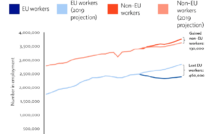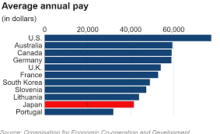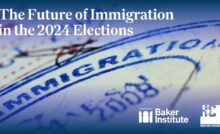A Closer Look at the Fastest Growing Minority Group in the United States


[ad_1]
Knowledge from the 2020 U.S. Census Bureau present that there are roughly 20.7 million Asian and Pacific Islanders in america—comprising 6.2 % of the U.S. inhabitants—that make up the quickest rising minority group in america.
Within the final decade, the U.S. Asian inhabitants grew by 35.5 %, reaching nearly 20 million individuals in 2020. For his or her half, Pacific Islanders additionally noticed strong progress, going from 540,000 to nearly 690,000, a rise of 28 %, from 2010 to 2020.
The 20.7 million sturdy AAPI neighborhood can be probably the most numerous within the nation not solely when it comes to ancestry but in addition when it comes to socioeconomic well-being. This displays the disparate histories that every group of Asians and Pacific Islanders has confronted in america.
In ancestry, the info present that Chinese language People have been the biggest AAPI group in america, numbering greater than 4.24 million, adopted by Indian People (4.21 million), and Filipino People (2.9 million). Amongst AAPI immigrants, India was the commonest nation of beginning, adopted by Mainland China, the Philippines, and Vietnam.


Supply: AIC evaluation of 2019 American Group Survey Microdata
Supply: AIC evaluation of 2019 American Group Survey Microdata
Whereas extra distinguished than ever in American public life, the rise in anti-Asian bias assaults and rhetoric have introduced new consideration to quite a few stereotypes which have lengthy plagued Asian and Pacific Islander People.
One of the problematic, the perpetual foreigner stereotype, depicts Asian American and Pacific Islanders as outsiders and aliens no matter the place they have been born or how lengthy they’ve lived in america. This all, after all, runs counter to actuality and information. Asians and Pacific Islanders have a protracted historical past in what’s now america, relationship again to the 18th century. After many years of serious immigration from Asia following the 1965 removing of discriminatory nation quotas, the AAPI inhabitants is more and more U.S.-born, with the U.S.-born AAPI inhabitants now rising sooner than the AAPI immigrant inhabitants.
The AAPI neighborhood is as numerous economically as it’s when it comes to ancestry. This runs counter to a different cussed stereotype, Asians as a ‘mannequin minority.’ This stereotype holds that every one Asians and Pacific Islanders are extremely educated and economically profitable. This has the impact of holding up chosen AAPI teams whereas hiding lingering challenges and struggles of many different weak Asian and Pacific Islander communities.
Taking a look at median incomes in 2019 among the many 15 largest AAPI ancestry teams, we discover a variety of median incomes. Indian People had the very best median earnings at $79.903, adopted by Taiwanese People ($72,832), Japanese People ($66,821), and Filipino People ($62,931), compared to a median earnings of $51,038 for non-Hispanic Whites. In the meantime, Bangladeshi People ($40,374), Hmong People ($41,378), and Nepalese People ($45,033) fell on the decrease finish of the earnings distribution. This represents a major earnings hole inside the AAPI neighborhood.
Supply: AIC evaluation of 2019 American Group Survey Microdata
Whereas the AAPI neighborhood contributes considerably to the economic system as an entire—for instance, AAPI households earned greater than $783.7 billion in earnings in 2019—a better look reveals that the AAPI neighborhood, and AAPI immigrants specifically, undergo from excessive ranges of earnings inequality. AAPI staff within the prime 10 % of the earnings distribution earn nearly 10 occasions what the underside 10 % of AAPI staff do. Amongst white staff, this ratio is far decrease at 7.8, and even decrease for Hispanic People at 7.5.
Additional contradictions exist as nicely. On common, greater than half, or 54.7 %, of Asian and Pacific Islander People have a school diploma, in comparison with barely 1 out of three individuals in america total. Whereas Asian and Pacific Islander People usually tend to have a school diploma, the next share of them lack a highschool diploma in comparison with the U.S. total. Because of this Asian and Pacific Islanders are disproportionately distributed on the reverse ends of the tutorial spectrum, whereas AAPI staff rank amongst a number of the highest earners in america, many others, particularly these with no faculty diploma, have much less steady and way more modest incomes.
Supply: AIC evaluation of 2019 American Group Survey Microdata
The connection between schooling and earnings can be not straight-forward. Whereas nearly half of all Bangladeshi American maintain a school diploma, as a neighborhood they undergo from a number of the highest poverty charges within the nation, with 19.1 % residing below the poverty line.
These information factors present a number of the super development that Asians and Pacific Islanders have made in america regardless of a troublesome historical past. This historical past contains the Chinese language Exclusion Act, the internment of Japanese People, wars in Indochina, violence towards Sikh People post-9/11, and most just lately, will increase in anti-AAPI sentiment through the Covid-19 pandemic. Whereas offering proof of with the ability to overcome these challenges, these information factors additionally expose areas the place critical challenges stay for a lot of AAPI communities, particularly AAPI immigrants and refugees in the case of questions of poverty, schooling, and authorized standing in america. With about one-fifth of the U.S. inhabitants progress now attributable to Asian and Pacific Islanders, the way forward for America is now inexorably tied to the well-being and success of the AAPI neighborhood.
[ad_2]
Source link
Recent Posts
New Immigration Pathways in Europe: A Breakdown of Digital Nomad Visas
The rise of remote work has paved the way for digital nomad visas, offering professionals…
Family Reunification Policies: How Different Countries Approach Visa Delays and Backlogs
Visa delays and backlogs have long been a challenge for families seeking reunification, and the…
Student Visa Changes in 2024: Key Updates in the US, Canada, Australia, and the UK
Student visa policies in the US, Canada, Australia, and the UK have seen significant changes…
The Impact of Global Inflation on Immigrant Communities
As global inflation continues to rise, immigrant communities are disproportionately affected. In many countries, the…
Climate Refugees: The Growing Role of Climate Change in Immigration Policy
Climate change is increasingly driving migration, with rising sea levels, severe droughts, and catastrophic weather…
Top Countries with Investor Visa Programs in 2024: Requirements and Benefits
Investor visa programs offer pathways to residency or citizenship in exchange for significant financial investment,…


